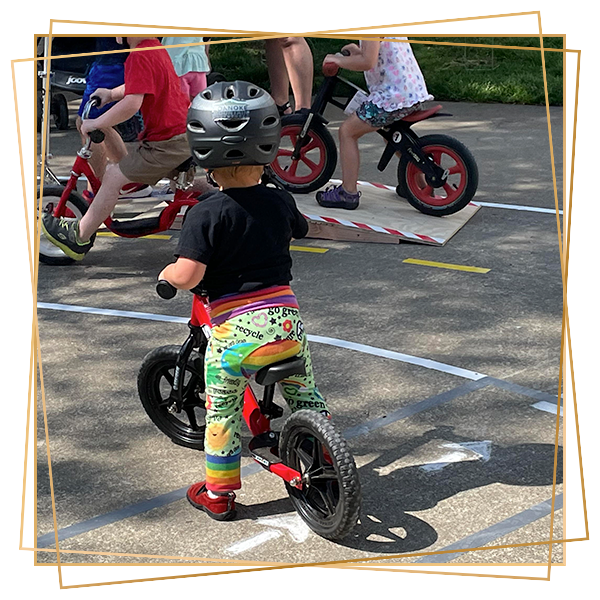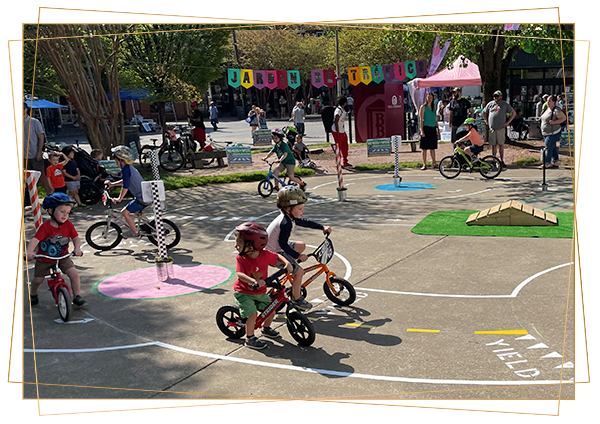Posted: February 16, 2023
Kids love wheels! It is a common sight to see tots riding various types of ride-on toys at preschools, daycares, or parks, but not all ride-ons are created equal. While many families already intuited it, emerging research is beginning to reveal the benefits and advantages of a specific type of ride-on toy, the balance bike.

A balance bike is the original bike--two wheels, a seat, and handlebars. It has no pedals and no chain. It's a simple device to ride and maintain. The seat is set low for the rider to fully plant their feet on the ground with their knees bent for stability and control. The rider intuitively pushes off the ground with their feet to move forward. Initially, this may look like toddling around atop two wheels, but young kids can soon shift to confident and smooth striding and gliding.
While bicycling is often thought of as something children only take up once they hit school age, the skill-building can start much earlier. In fact, the joy and fun of bicycling can become part of younger kids' lives soon after they learn to walk. And all the other benefits follow along!
Introducing balance bikes early allows kids to start building familiarity and subtle physical patterning associated with sitting on a bike seat, holding onto handlebars, and maneuvering with arms and hips. They help with gross motor, vestibular, cognitive, proprioceptive, and even social development. They position kids to take part in an inclusive and low-cost mode of transportation and recreation that will continue to help their physical, mental, and financial health throughout their lives. Indeed, biking can be a source of pride and elation, and offering that experience to children can be a gift.
Once kids are a bit older, around age 5, balance bike activities can also be paired with other tools like traffic gardens. Riding and taking in other age-appropriate foundational media content about road safety and street layout, children can prepare to be competent and responsible pedestrians and bicyclists as they grow. Or rather, they could, but often they never get the chance. Few people are focused on babies on bikes.

The Early Childhood Mobility Coalition (ECMC), born at the National Bike Summit in Washington DC in March of 2021, brings stakeholders and practitioners together to bridge the gap in mobility education for kids from 0 to 8 years old. The group includes League of American Bicyclists Certified Cycling Instructors, designers, educators, and active transportation proponents from across North America. ECMC has assembled resources related to balance bikes, among other kids-and-mobility-related topics, online at kidswalkbike.com.
ECMC has identified the following barriers to widespread adoption of balance bikes in the US:
- Awareness - Although balance bikes have long been in use in other countries, many parents, caregivers, and early childhood educators here are not familiar with them, either as a riding device or as a superior method for learning biking skills. Balance bikes have only entered the U.S. market in the past decade.
- Confidence - For adults who see balance bikes as new and untested, the idea of making balance bikes available to kids in their care may be a concern. This is easily addressed with a basic introduction for parents and teachers and opportunities to learn more. (Start with helmets, seat adjustment, safety check, and location selection--a level place with no obstructions or vehicles to interact with--and get rolling. Then mostly just be encouraging: "Good job!")
- Access - Some U.S. households already use balance bikes to complement the scooters, scoot carts, and other toys they have. But not everyone can afford yet another bike, not everyone has space for them, and few need access to them for very long (though even kids who have already mastered pedal bikes can still have fun with them!).
The good news is that all of these challenges can be overcome!
ECMC is working to address the lack of awareness and get information out about the basic concepts of early childhood cycling education, the tools involved, the benefits of using them, and suggestions for how to incorporate them into daily life, kids' education, and active transportation planning and advocacy.
In addition to awareness, ECMC also works to highlight best practices for access. Adding balance bikes in shared resource settings like daycares, preschools, community centers, parks and rec centers, and schools is an optimal solution for equity. Simply providing a few balance bikes for use in communal early childhood education settings can ensure broad access for lots of kids.
Confidence is also something that builds up gradually as people get more familiar with the concept. ECMC is involved in events and outreach now and is working to provide resources to help caregivers provide support and encouragement in a safe environment. You don't have to be a professional cyclist to help kids get engaged with an important form of physical activity and a potential lifelong fun and healthy habit!
Article by Samantha Pearson, Early Childhood Mobility Coalition
Resources
Early Childhood Mobility Coalition - kidswalkbike.com
Learning to ride using balance bikes
- Model Canadian preschool balance bike program - Kids on Wheels
- Balance Bikes in use at the 2022 Philly Bike Expo Kids' Arena - video
- Psychomotor Development, learning to ride a balance bike - video
Balance bikes and traffic gardens
- Discover Traffic Gardens website
- Cover story in December 2022 issue of Parks & Recreation Magazine
- National Highway Transportation Safety Association - Traffic gardens video

